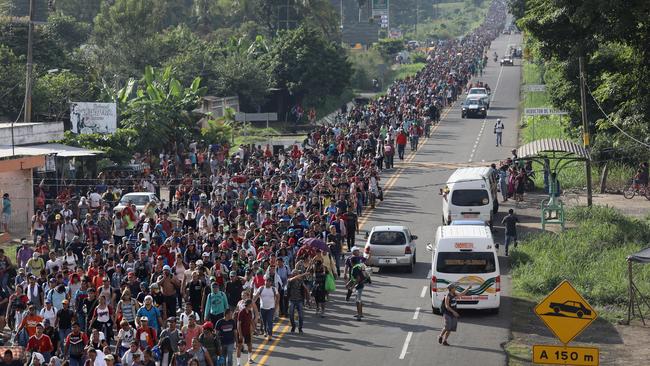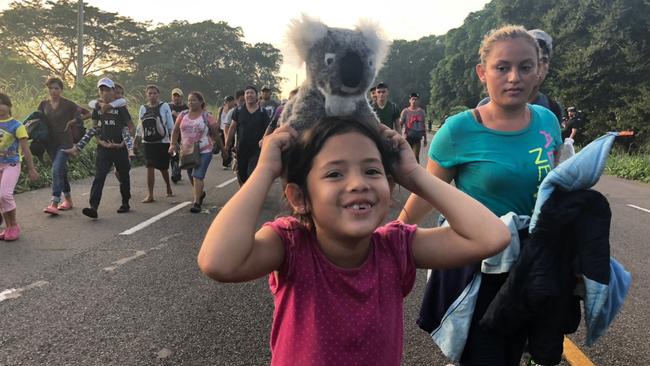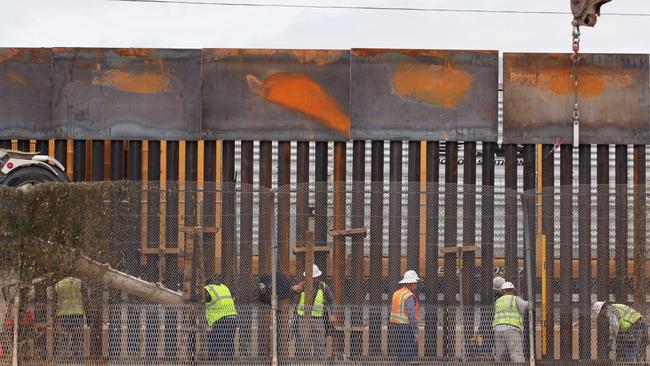Migrant caravan moves north across the hot spots of Mexico
The march of 5000 Hondurans towards the US border has energised the midterm elections.

On Mexico’s migrant caravan a young child carries a stuffed koala on her shoulders, oblivious to the uncertainties and peril that lie ahead. She has been swept up in a zeitgeist moment that has energised the midterm elections in the US and strained relations across Latin America.
After spreading like wildfire, first on social media and then on Honduras national television, news of the caravan prompted thousands spontaneously to join a march north to the US. Many falsely believed they would be paid for making the journey. They are hoping for jobs and a new life, or to return to families living in a First World country from which they have already been expelled.
Interviews from the frontline paint a picture of a flight from lawlessness, extortion and lack of opportunity.
Rosa Dubon, 34, tells Fox News she fled Honduras with her two-year-old and four-year-old after members of crime gang MS-13 started to make people pay monthly fees. Her older sons, she says, have already fled after gangs back home tried to recruit them.
“There is no going back,” she says, standing under a bridge on a highway outside of Tapachula in Mexico’s south.
The stories are not new. They are the same as those told to Inquirer by refugees who have escaped the notorious northern triangle of Honduras, El Salvador and Guatemala for refuge in Costa Rica and the hope of resettlement in Australia.
But the latest mass exodus from Honduras threatens to become a stampede from across the northern triangle, with reports that new caravans are forming behind the first.
Like migrating wildebeest on the African plains, vulnerable people are seeking safety in numbers to search out greener pastures. About 5000 migrants are already marching northwards in Mexico’s southern Chiapas state, according to Mexican authorities, while close to 1700 Hondurans who requested asylum have been sent to a shelter run by Mexican migration authorities in the city of Tapachula, near the border with Guatemala. Hundreds of them travelled with children and babies.
In the heat of the US midterm elections, the first caravan of refugees has breached the Mexico border and overwhelmed, or ignored, efforts to process individual claims for sanctuary.
The caravan and blanket media coverage has provided for Donald Trump a “Tampa moment”, a galvanising focus to reassert a central theme of his successful presidential campaign to build a wall against Mexico.
In response to the caravan, the US President this week sought co-operation from Mexico and threatened to cut aid to the northern triangle governments that are failing their people. He says US troops will close the border with Mexico if necessary to stop the arrivals he claims have been infiltrated by gang members and others from the Middle East.
The US ambassador to the UN, Nikki Haley, has said publicly there are political motives behind the exodus.
“Honduran politicians allied with Venezuelan and Cuban socialist dictators are encouraging the caravan to undermine the US-friendly (Honduran) government of President Juan Orlando Hernandez,” Haley said.
The issue has become a stick to beat the Democrats who have refused to negotiate the tougher border protection measures championed by Trump.

For Mexico, the caravan presents a logistic as well as diplomatic dilemma. Mexico has been running an increasingly tough immigration policy on its southern border, in part to build relations with its powerful northern neighbour, but is also mindful of a deeply compassionate community sentiment at home.
The flip side is a natural aversion in Mexico to any suggestion of subservience to the US and concerns about increasing levels of violence and resentment in communities where the Central American migrants have previously settled.
It is a juggling act that allowed Mexico to renegotiate a free trade agreement with the US and de-escalate Trump’s rhetoric over the building of a wall on the US border. Mexican President Enrique Pena Nieto has called on the UN for help and warned if members of the caravan do not follow the law and register with Mexico, they will be unlikely to reach their goal — “be it entering the United States or staying in Mexico”.
To complicate matters, government in Mexico is in transition to a left-leaning president-elect, Andres Manuel Lopez Obrador, commonly referred to by his initials, AMLO.
AMLO will take control in December and is championing what appears to be a more open-door policy for Central Americans wanting to work in Mexico.
AMLO says his administration will give employment visas to those who leave their Central American countries. Incoming Mexican secretary of the interior Olga Sanchez Cordero says migrants will be employed in the construction of major new infrastructure works including a high-speed train along the Caribbean coast, known as the Maya Train, rehabilitation of the Isthmus of Tehuantepec and the planting of one million hectares of fruit trees and timber.
However, none of this will help the caravan, which is squashed between the realpolitik of their dysfunctional homelands and multilateral relationships they are unlikely to comprehend.
Despite reaching Mexico they face a perilous journey north, and a hostile reaction from the US if they make it to the border.

To put things in perspective, the caravan is now in the southern state of Chiapas, one of Mexico’s poorest regions. The US border is more than 1500km to the north, a crippling march through the blistering tropics and then cold-region mountains.
All along the way are people who are willing and waiting to prey on the weak.
Migrant-charity workers say the arrival of more caravans could signal a new dynamic as migrants band together to seek to avoid hiring human traffickers, known as coyotes, who charge between $US4000 ($5700) and $US8000 a person for dangerous treks to the US border. Another crucial factor: large caravans are also a lot safer for migrants as they cross some of the world’s most murderous countries.
If they keep walking, the next big centre for the caravan will be Salina Cruz, a grimy industrial port city and petrol refinery centre on the Pacific coastline from which crime gangs have launched homemade submarines to smuggle cocaine and other drugs to neighbours in the north.
From Salina Cruz there is a long stretch of windswept coastline until the caravan will most likely turn inland to cut across the isthmus, the neck of land where the distance between the Gulf of Mexico and the Pacific Ocean is shortest.
On the Gulf Coast they will find another gangster hot spot, Veracruz. This is where authorities recently discovered at least 166 human skulls in 32 burial pits, deadly confirmation of the intense murder and crime wave that has gripped the country.
The alternative is to push north and risk the violent cartel-controlled territories around Acapulco where the Mexican military last month disarmed and suspended the entire municipal police force amid a murder and corruption investigation.
The land bridge between the Pacific Coast and the Gulf of Mexico is a journey Inquirer has made twice in recent months. On both occasions the road has frequently been blocked by military checkpoints. Heavily armed soldiers stop and search passing vehicles in a bid to stem the flow of cocaine, illegal migrants and cartel members along what has always been a major smuggling route from Central America to the US.
The International Crisis Group has been tracking the complex mix of migration, crime and US-Mexico relations for many years. In a substantial report in May this year, the ICG says Mexico should stop using migration policy as a bargaining chip with the US and instead redouble efforts to protect migrants and refugees, fight crime and promote development in the southern states.
It says the US and EU should provide material assistance for refugee processing and protection, and support efforts to reduce poverty and crime in Central America so that fewer people are compelled to flee.
At present, the report says, Mexico effectively acts as an operating arm of US immigration control. It stops hundreds of thousands of Central Americans from travelling north, deporting more of them than the US since 2015, while also granting thousands refugee status.
From January 2015 to September 2018, Mexico deported 436,125 Guatemalans, Salvadorans and Hondurans, while the US deported 293,813 migrants.
This has bred resentment and danger for those who follow.
“Central American refugees’ escape from violence is far from assured,” the ICG report says.
In 2017, Mexico recorded its highest number of murders since the country’s modern record-keeping began. Homicide rates in the southern states of Oaxaca, Quintana Roo and Veracruz are above the national average and rising. Kidnappings have soared across the south since 2015.
“Not only are the border states now the main conduit for cocaine trafficked from Colombia’s Pacific coast, but violence is fuelled by the fragmentation of the once dominant Zetas and the Sinaloa Cartel, combined with the rise of the Jalisco New Generation Cartel and the spread to southern Mexico of Central American street gangs, notably the Mara Salvatrucha (MS-13),” the ICG says.
“The proliferation of cartels and gangs has intensified turf battles over protection rackets. Long the victims of crime while travelling north, Central Americans must now run an extended gauntlet of criminal organisations ready to kidnap, physically and sexually abuse, or kill them.”
There is broad agreement that deeper economic co-operation is a key to controlling migration.
White House chief of staff John Kelly told a conference last year that he and Trump believed securing the southwestern border “begins 1500 miles south”, in partnerships with Mexico and countries further afield.
However, in response to the caravan Trump is likely to drive a hard bargain, pushing Mexico to shoulder more of the load.
In an executive order in January 2017, Trump proposed a return of non-US citizens or nationals seeking entry to the US from a contiguous territory “to the territory from which they came”, mainly Mexico, where they were to wait “pending a formal removal process”.
Mexico has refused to accept returns of non-Mexican nationals.
Meanwhile, the US congress has attempted to give Homeland Security secretary authority to declare Mexico a “safe third country” for asylum applicants, despite evidence to the contrary.
The refugee caravan has dramatically raised the stakes.
ICG argues while the US government clearly is intent on buttressing its own southern border against Central Americans, it should compensate for the resulting pressure on Mexico.
Much will depend on how the incoming Mexican president chooses to respond. AMLO has already signalled a willingness to open the door for those who want to work. He could toughen Mexico’s stand against the US or he could see it as an opportunity to get the resources needed to deliver on his bigger promise to drag the poorest regions of his country from the jaws of crime and poverty.



